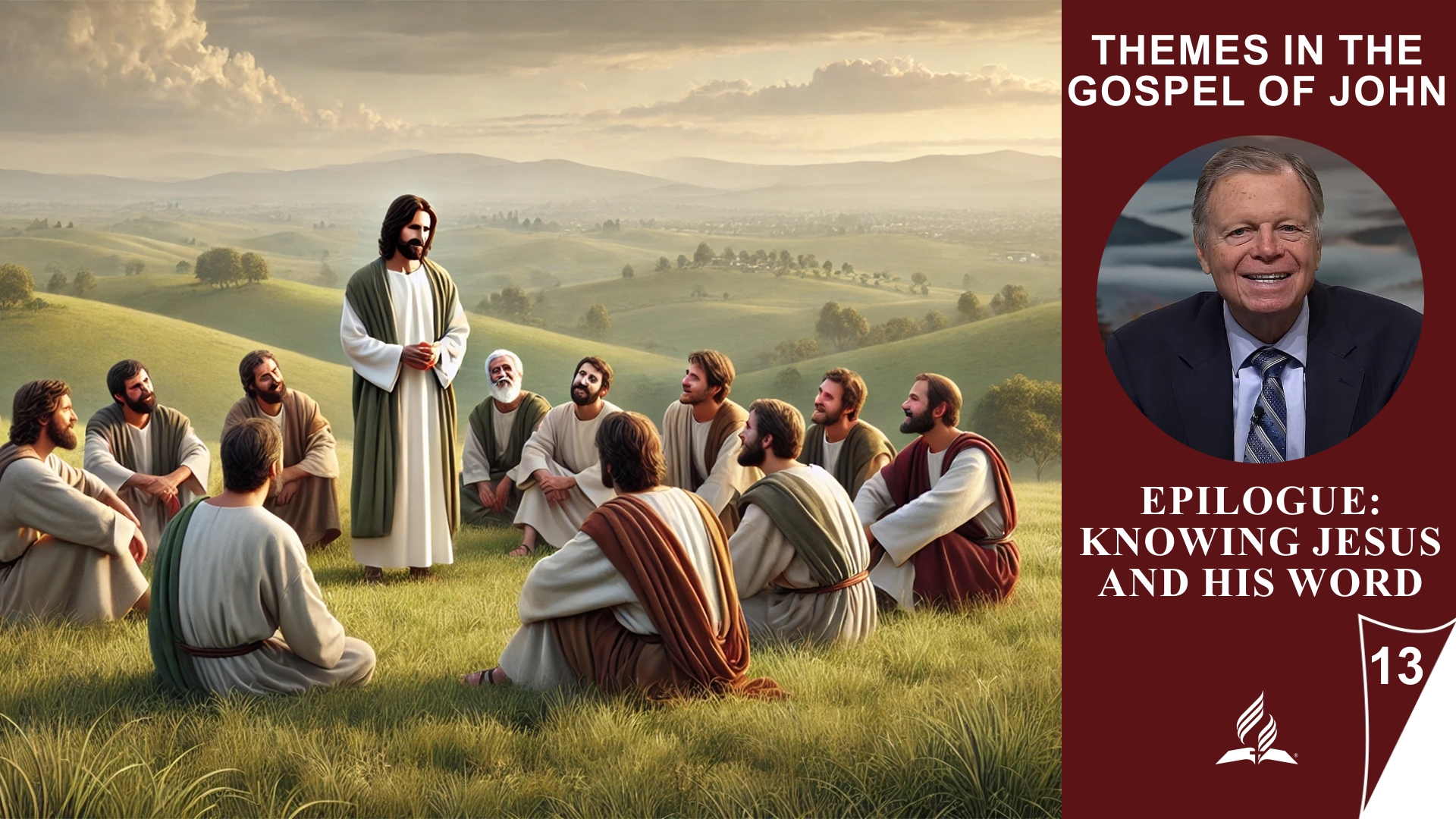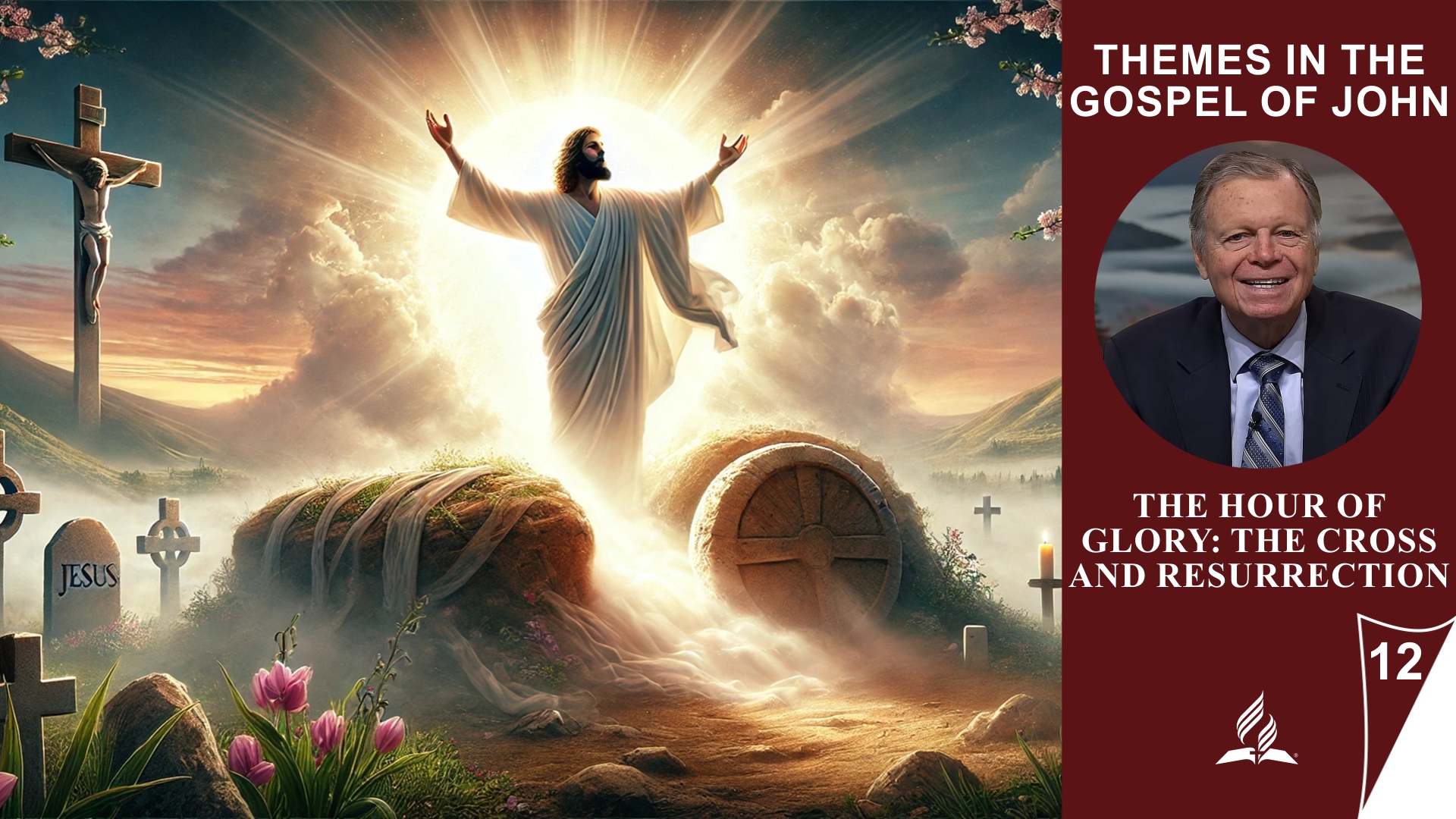
The God of Love and Justice – Lesson 1.God Loves Freely | Sabbath School with Pastor Mark Finley

Series THE GOD OF LOVE AND JUSTICE with Pastor Mark Finley |
Lesson 1.God Loves Freely |
The Immeasurable and Unconditional Love of God |
God’s love is the foundation of our faith and our relationship with Him. But what does it mean that God loves us freely, regardless of our actions or our worthiness? Lesson 1 guides us through various aspects of this amazing truth: God’s unwavering faithfulness to His people despite their unfaithfulness, His invitation to a love that is not coerced, and the ultimate revelation of His love on the cross. This lesson invites us to reflect on the depth and breadth of God’s free and unmerited love—and how we can respond to this love in our lives.
Memory Text: Hosea 14:4 – “ ‘I will heal their backsliding, I will love them freely, for My anger has turned away from him’ ”
Content:
1.1 Beyond Reasonable Expectations
Beyond Deserved: God’s Love and Grace Without Limits
God’s love is boundless and undeserved. Although the Israelites betrayed God by worshiping the golden calf after their liberation from Egypt, God remained faithful to them. This faithfulness is evident in Exodus 33:19, where God declares that His grace and mercy will be freely given, even when they are not deserved. This statement does not illustrate arbitrariness but God’s sovereign decision to bestow love and compassion even on the unworthy. The story shows that God’s love exceeds all reasonable expectations. This is a comforting message for us all: God’s love and grace are greater than our faults.
1.2 Unrequited Love
Despite Unfaithfulness: God’s Voluntary and Unwavering Love
The story of Hosea is a vivid depiction of God’s unmerited and unwavering love. Despite Israel’s repeated unfaithfulness, God demonstrates through Hosea’s relationship with his unfaithful wife that His love is freely and voluntarily given, regardless of human unworthiness. Hosea 14:1–4 reveals God’s willingness to offer healing and love even when the relationship seems irreparable. The term “freely” in “I will love them freely” emphasizes that God’s love is voluntary and without coercion. This love is not only a divine gift but also a call to repentance. This image of a faithful lover who loves despite rejection shows God’s deep longing for a relationship with us and changes how we can perceive His grace and faithfulness.
1.3 Love Freely Given
Out of Free Will: God’s Boundless and Undeserved Love
God’s love is an undeserved and voluntary gift that depends neither on our worthiness nor on a need of God. Although God did not need creation, He chose out of pure love to create the world and engage in a relationship with us. Revelation 4:11 and Psalm 33:6 demonstrate that God created out of His free will and is therefore worthy of all honor and worship. Even after the fall in Eden, God continued His love and upheld creation in His grace. This voluntary love reveals God’s unchanging character and His willingness to reconcile a lost humanity. This truth should inspire us to love Him wholeheartedly and follow His ways.
1.4 Many Are Called, but Few Are Chosen
God’s Invitation: Many Called, Few Willing
God’s invitation to the wedding feast in Christ’s parable reveals His love and the free will He gives to each person. God calls everyone, but not everyone responds. Matthew 22:1–14 shows that the “Chosen Ones” are those who accept God’s invitation and prepare for the wedding by wearing the king’s wedding garment—a symbol of accepting God’s grace and righteousness. God’s love is universal, but He does not force anyone to reciprocate it. The freedom to accept or decline God’s invitation is crucial because true love can never be coerced. The question remains: Are we willing to accept God’s invitation and live in His love?
1.5 Crucified for Us
The Ultimate Sacrifice: God’s Love Revealed on the Cross
On the cross, God’s immeasurable love is revealed, surpassing all human understanding. Jesus Christ willingly gave His life to pay for the sins of humanity and to heal the broken relationship between heaven and earth. Although many, as described in Matthew 23:37, were not willing to accept God’s invitation, Christ still went to the cross—for them and for us. John 10:17-18 and Galatians 2:20 illustrate that this sacrifice was made out of His free will as part of a plan established before the foundation of the world. This act shows that God’s love is not only saving but also intentional and selfless. The cross is an eternal testimony to God’s unmerited, free love for all of us.
1.6 Summary
The Essence of Divine Love: Faithfulness, Freedom, and Invitation
God’s love is a gift that is given freely and without condition. In the history of Israel, in the parable of the wedding banquet, and ultimately on the cross, God demonstrates that His love is independent of human worthiness or performance. Despite repeated unfaithfulness, God remains faithful and continues to invite us into a relationship with Him. His love is not forced but is based on His free will and unchanging nature. The cross is the ultimate expression of this love, as Christ willingly gave His life to save us. Lesson 1 reminds us that God’s love not only seeks us but also invites us to freely reciprocate it.
Themes in the Gospel of John – Lesson 13.Epilogue: Knowing Jesus and His Word | Sabbath School with Pastor Mark Finley

Series JESUS IN THE GOSPEL OF JOHN with Pastor Mark Finley |
Lesson 13.Epilogue: Knowing Jesus and His Word |
Getting to Know the Master and His Word |
Lesson 13 invites us to recognize Jesus and His Word in a deeper way. Through encounters, such as the one between Jesus and Peter, it becomes clear that God’s grace and our humility are the keys to true discipleship. The Gospel of John shows how people respond to Jesus—either by accepting the light and growing or by rejecting it and remaining blind. It teaches us to base our faith not on human ideas but on God’s Word.
The lesson reminds us that spiritual growth depends on staying in Jesus, trusting Him, and allowing His truth to work in our lives. Jesus is the center of all understanding, the light that shows us the way to the Father.
Memory Text: John 5:39 – “ ‘You search the Scriptures, for in them you think you have eternal life; and these are they which testify of Me’ .”
Contents:
13.1 Meeting in Galilee
A New Beginning in Grace and Humility
John 21:1–19 reveals profound truths about God’s grace and human humility. The scene shows how Jesus meets the disciples, especially Peter, in Galilee and gives him the opportunity for restoration. Peter, who once denied Jesus three times, is now asked three times if he loves Him, symbolizing a deliberate restoration. In doing so, Peter recognizes his own inadequacy and responds humbly. This demonstrates that true humility—the awareness of one’s own faults and dependence on God’s grace—is essential for ministry and spiritual growth.
Jesus’ command to Peter to “feed my sheep” makes it clear that God’s forgiveness and calling do not depend on human perfection but on the willingness to place God at the center. This event is a powerful reminder that no one can stand before God based on their own achievements, but only through His immeasurable grace.
13.2 Keeping Your Eyes on Jesus
The Key to Discipleship
In John 21:20–22, it becomes evident how quickly the focus can shift from a personal relationship with Jesus to the circumstances of others. Peter curiously asks about the fate of John, but Jesus corrects him by saying, “What does it matter to you? Follow me!” This response shows that the path of discipleship is individual and not based on comparisons. Jesus redirects Peter back to the essential task: to focus on Him and fulfill His calling.
The misunderstanding about Jesus’ words—that John would remain until His return—highlights the importance of correctly understanding His message. John clarifies this confusion and refocuses attention on the central message: the focus should be solely on Jesus, our Savior and Master. This episode serves as a reminder that distractions and comparisons can lead us astray—the only path we should follow is the one Jesus shows us.
13.3 Light and Darkness
The Path to Truth
The texts from the Gospel of John emphasize the strong contrast between light and darkness, which is fundamental to understanding the truth. Light symbolizes Jesus Christ, who brings the truth and revelation of God, while darkness represents the world and its turning away from God. People often avoid the light because it exposes their actions, but only through the light can they recognize the true God. This contrast shows that true knowledge and relationship with God are not possible through our own strength but only through Jesus and the Holy Spirit.
Jesus makes it clear that faith based on a false foundation is dangerous, as was the case with the religious leaders of Israel. They relied on human perspectives and rejected the truth revealed in Christ. For us, this means that we must always measure our interpretations and reactions by the light of Christ, especially when biblical truths are challenging. Only then can we overcome the darkness of human misinterpretations and walk in the truth.
13.4 Theology From “Above” or From “Below”
Faith That Goes Beyond Human Ideas
A royal official came to Jesus with the desperate request to heal his sick son. However, his initial faith was based on the expectation of visible miracles—a “from below” theology that ties God’s actions to human conditions. But Jesus challenged him to believe His word without visible proof. The true theme here is the transition from a conditional faith to a trust that is based solely on Jesus and His Word.
Theology “from above” acknowledges God’s sovereignty and is guided by the Word of God, not by human ideas. Faith that springs from a loving relationship with Jesus leads to obedience that comes from the heart, not from legal obligation. Without love, obedience becomes a mechanical fulfillment of duty. But when love is the foundation, obedience becomes an expression of devotion and joy in God’s will.
13.5 Abiding in Jesus
The Key to True Discipleship
In John 12:32, Jesus describes His authority as one that draws all people to Himself when He is lifted up. This statement shows that Jesus is the central figure for understanding God’s will and the truth. The Gospel of John makes it clear that encounters with Jesus require decisions: either to accept the light and grow or to reject it and remain blind. Spiritual growth and health are only possible if we remain in Jesus, as illustrated by the relationship between the branches and the vine in John 15:1–11.
Jesus is the source of all life and truth. To grow spiritually, we must submit to His Word and His guidance, without placing our human ideas above divine truth. Faith rooted in Christ leads to a life that bears fruit and stands in love and obedience to God’s will. Thus, the Bible becomes the foundation by which everything is tested—the anchor for true life and true understanding.
13.6 Summary
Jesus—The Light That Leads to Truth
In Lesson 13, it is emphasized that encountering Jesus Christ requires a profound decision from each person. The disciples, especially Peter, experience God’s grace and forgiveness, which must be accepted through humility and faith. The contrast between light and darkness shows that true understanding and discipleship are only possible through turning to Jesus. Theology “from above” teaches us to trust God and place His Word above human ideas.
The secret to spiritual growth lies in remaining in Jesus, being guided by His Word, and bearing fruit for His kingdom. This lesson calls us to recognize Jesus as the center of our lives and to deepen our relationship with Him through faith, obedience, and love.
Themes in the Gospel of John – Lesson 12.The Hour of Glory: The Cross and Resurrection | Sabbath School with Pastor Mark Finley

Series JESUS IN THE GOSPEL OF JOHN with Pastor Mark Finley |
Lesson 12.The Hour of Glory: The Cross and Resurrection |
The Cross and the Resurrection: The Turning Point of History |
Lesson 12 deals with the central events of the Christian faith: the death and resurrection of Jesus Christ. This week, we explore how the cross represents the fulfillment of God’s plan to save humanity and how the resurrection transforms the empty tomb into a symbol of hope. From the trial before Pilate to the encounter between the risen Christ and Mary Magdalene, God’s love and grace are powerfully demonstrated. Jesus’ last words, “It is finished,” mark the victory over sin and death. This lesson invites us to reflect on the significance of the cross and resurrection for our own lives and to embody the hope of the resurrection in our daily lives.
Memory Text: John 18:37 – “Then Pilate said to him, ‘So you are a king?’ Jesus answered, ‘You say that I am a king. For this purpose I was born and for this purpose I have come into the world—to bear witness to the truth. Everyone who is of the truth listens to my voice’.”
Content:
12.1 What is Truth?
The Truth Stands Before Us: Pilate’s Missed Opportunity
The encounter between Jesus and Pilate in John 18:33–38 is more than just a political interrogation—it is a profound confrontation with the truth. Jesus makes it clear that His kingdom is not of this world and reveals that He has come to testify to the truth. Pilate’s question, “What is truth?” reflects his inner turmoil and confusion, yet he seeks no real answer. Instead, he ignores the truth that stands right before him and chooses the more convenient path, shaped by prejudice and external pressures. In the Gospel of John, truth is inseparably linked with Jesus, who is “the way, the truth, and the life.” This episode calls us to overcome our own prejudices and fears to recognize and accept the truth in Jesus.
12.2 Behold the Man!
The Irony of Judgment: The True King and the Lamb of God
In John 18:38–19:5, Pilate attempts to release Jesus by leaving the decision to the crowd. He presents Jesus, mocked and humiliated with a crown of thorns and a purple robe, saying, “Behold the man!” However, his strategy fails: the religious leaders and the people choose Barabbas instead of Jesus. Ironically, Pilate unknowingly presents Jesus not only as a ridiculed king but also as the Lamb of God who bears the sin of the world. This scene illustrates how political power, fear, and hatred can suppress truth and justice. It is telling that a pagan governor hesitates more to condemn Jesus than the spiritual leaders who should have recognized Him. This story warns us to be vigilant against prejudice and abuse of power and to courageously defend the truth.
12.3 “It Is Finished”
The Completed Work: Hope Through Jesus’ Sacrifice
The words “It is finished” mark the culmination of Jesus’ mission. On the cross, He completed the work of redemption that the Father had commissioned, fulfilling Scripture in every aspect. Pilate’s inscription, “Jesus of Nazareth, the King of the Jews,” became a silent testimony to Jesus’ true identity, even though it was intended as mockery. In the moving scene where Jesus entrusts His mother Mary to John, it is evident that even in suffering, His love and care for others are paramount. Jesus’ death is not the end but the beginning of new hope for humanity. For us, His accomplished work means forgiveness, redemption, and the possibility of living in a renewed relationship with God.
12.4 The Empty Tomb
The Empty Tomb: A Sign of Resurrection and Hope
The empty tomb is the central proof of Jesus’ resurrection and gives us the assurance that death does not have the final word. The description of the folded burial cloths, especially the linen wrappings, emphasizes that Jesus’ resurrection was not the work of grave robbers but a deliberate and divine act. John saw and believed—the order and calm in the tomb convinced him that something supernatural had occurred. For Jesus’ followers, this event marks the fulfillment of His promises and the foundation of their faith. Jesus’ resurrection means hope for new life and the overcoming of death and sin. The empty tomb challenges us to live in this living hope.
12.5 Jesus and Mary
A Personal Revelation: Mary Recognizes the Risen Lord
Mary Magdalene experiences a turning point in history at the empty tomb. Despite her grief and confusion, she is personally addressed by Jesus, and only by hearing her name does she recognize Him. This encounter demonstrates the personal relationship Jesus has with His followers. His resurrection changes everything—it not only brings comfort to Mary’s sorrow but also gives all of humanity hope and life. Mary becomes the first witness to the resurrection and is entrusted with spreading this message to the disciples. Without the resurrection, as Paul emphasizes in 1 Corinthians 15:12–20, our faith would be in vain. But through Jesus’ resurrection, we have a solid foundation for our faith and hope.
12.6 Summary
The Cross and Resurrection: The Climax of God’s Plan of Redemption
In Lesson 12, the significance of Jesus’ crucifixion and resurrection is highlighted as the climax of His redemptive work. During His trial before Pilate, Jesus explains that He has come to testify to the truth, yet people miss this truth through prejudice and power plays. On the cross, Jesus completes His mission with the words “It is finished,” bringing hope and redemption for humanity. The empty tomb confirms His resurrection and demonstrates that death has been overcome. Mary Magdalene, as the first witness to the resurrection, is personally addressed by Jesus and entrusted with the task of proclaiming the good news to the disciples. These events call us to live in the hope and faith of the resurrection and to accept the gift of redemption.
Themes in the Gospel of John – Lesson 11.The Father, the Son, and the Spirit | Sabbath School with Pastor Mark Finley

Series JESUS IN THE GOSPEL OF JOHN with Pastor Mark Finley |
Lesson 11.The Father, the Son, and the Spirit |
The Trinity: Unity in Love, Truth, and Redemption Plan |
Lesson 11 is dedicated to the relationship between the Father, the Son, and the Holy Spirit, demonstrating how the divinity works together in the creation and redemption of humanity. This unity in love, truth, and purpose is vividly described in the Gospel of John. The Father is the source of life and love, the Son reveals the Father through His life and sacrifice, and the Holy Spirit acts as the mediator of divine truth and power. Together, they work to restore humanity into a close relationship with God. This lesson invites us to recognize the love and unity of the divinity and to reflect it in our lives.
Memory Text: John 14:26 – “‘The Helper, the Holy Spirit, whom the Father will send in My name, He will teach you all things, and bring to your remembrance all things that I said to you’.”
Content:
11.1 The Heavenly Father
The Father: Origin of Love and Source of Redemption
The Gospel of John clearly highlights the central role of the Father in the redemption plan. The Father is at the center of creation and is actively involved in the redemption of humanity. John 3:16-17 reveals God’s immeasurable love by sending His Son to save the world. The Father works in close unity with Jesus, as emphasized in John 10:30: “I and the Father are one.” These verses show that the Father has assigned works to Jesus that reveal His divine nature and that He is the source of true teaching and guidance (John 14:10). God’s care and love are active and personal; He hears our prayers (John 16:23) and draws us to Himself through His grace (John 6:45). This truth testifies to the depth of the Father’s love for us and how intimately He is connected with humanity.
11.2 Jesus and the Father
Jesus: Revealer of the Father and Restorer of the Relationship with God
Sin has profoundly disrupted the personal relationship between humanity and divinity as planned by God, as clearly depicted in Genesis 3. However, instead of leaving humanity in separation, God actively sought them, demonstrating His immeasurable love and grace. Jesus, the Word, became flesh to reveal the Father’s glory and love (John 1:14–18). Through His life and sacrifice, He offered humanity the opportunity to restore the broken relationship. The verses from John show that Jesus and the Father work in perfect unity to grant redemption and eternal life. In Christ, we find not only hope but also the assurance that God actively approaches us in His love to save us.
11.3 Knowing the Son Is Knowing the Father
Jesus: The Way to the Father and Revealer of His Will
Jesus is the perfect revelation of the Father, as emphasized in John 1:18. Through His words and actions, He shows who the Father is and how closely He is connected with humanity. Jesus’ mission was to fulfill the Father’s will on earth, not His own (John 5:30), and in this submission, He reveals the unity between Himself and the Father. Jesus emphasizes that He was sent by the Father to redeem humanity and grant eternal life (John 6:40). His teachings and works are directly inspired by the Father, and He always acts in complete accordance with God’s will. This unity in love and action shows us that faith in Jesus is simultaneously faith in the Father—a central message of the Gospel.
11.4 The Holy Spirit
The Holy Spirit: Renewer and Guide into All Truth
The Holy Spirit plays a central role in Jesus’ mission and in the conversion of believers. John 1:13 shows that the new birth—the becoming of children of God—does not happen through human effort but solely through the work of the Spirit. The Holy Spirit is the divine power that helps us overcome sin, recognize righteousness, and find true life in Christ (John 3:5–8; 16:8–11). Jesus promised the disciples that the Spirit would come as a helper and teacher to lead them into all truth (John 14:26). Without the Holy Spirit, Christ’s sacrifice would have been ineffective. His role is to renew, strengthen, and lead believers to the knowledge of God—a priceless blessing.
11.5 The Prayer of Jesus
Jesus’ Prayer: Unity in Love and Truth
The prayer in John 17 reveals Jesus’ deep desire for unity and love among Himself, the Father, the Holy Spirit, and His disciples. It shows that Jesus wanted to lead people not only to love but also to truth. “Sanctify them by the truth! Your word is truth” (John 17:17) emphasizes that a genuine relationship with God is based on the knowledge of truth. Jesus took His mission to reveal the Father very seriously to correct misunderstandings about God and to lead humanity back into fellowship with God. Despite rejection, betrayal, and suffering, Jesus remained faithful to His mission to make the Father’s love and truth visible. His prayer is a call for us to reflect this love and unity in our lives.
11.6 Summary
The Unity of the Divinity: Love, Truth, and Redemption
Lesson 11 illuminates the close relationship between the Father, the Son, and the Holy Spirit, as well as their roles in creation, redemption, and guidance of humanity. The Father is the source of all love, the Son reveals God’s nature through His life and sacrifice, and the Holy Spirit acts as the renewer and guide into all truth. Jesus demonstrated that the unity of the divinity is based on love, truth, and a common goal: the restoration of humanity into fellowship with God. Jesus’ high priestly prayer (John 17) emphasizes this unity and the desire for believers to partake in it. The lesson calls us to reflect God’s love and truth in our lives and to cultivate a personal relationship with the divinity.
- « Previous Page
- 1
- …
- 6
- 7
- 8
- 9
- 10
- …
- 384
- Next Page »
